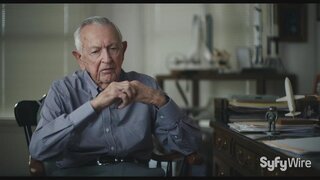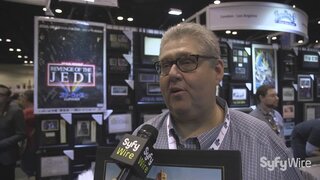Create a free profile to get unlimited access to exclusive videos, sweepstakes, and more!
Remembering Apollo Astronaut William Anders and His Famous Earthrise Photo
William Anders only went to space once, but he made it count!
If you came of age during or after the Apollo missions, you probably take it for granted that we live in a world in which people have walked on the Moon, a world in which astronauts live and work in space every day. It isn’t outside the realm of possibility for a child to look at the Moon, say “I’m going to go there,” and be correct. But that wasn’t always the case, a little more than 50 years ago a small group of pioneering astronauts cut a path through translunar space, from here to the Moon, for the very first time.
The documentary First the Moon (streaming now on Peacock) combines archival footage from NASA and the National Archives, as well as the personal collections of astronauts to tell the story of the first crewed mission to the Moon and the people who flew it. Apollo 8 launched on December 21, 1968, from launch complex 39A at Kennedy Space Center in Florida. It was the second crewed mission of the Apollo program and the first crewed flight to leave Earth orbit for the vicinity of the Moon.
The Apollo spacecraft carried Commander Frank Borman, Command Module Pilot Jim Lovell, and Lunar Module Pilot William Anders. On Friday, June 7, 2024, Anders died in a plane crash off the coast of Washington, he was 90 years old.
For More on Apollo:
If Apollo Astronauts Had Brought Back a Moon Plage we Couldn't Have Stopped It
Apollo Rocks Reveal the Moon's Past was a Magnetic Game of 'The Floor is Lava'
Is the 50-Year-Old Ghost of Apollo 13 Warning Us Not to Rush to the Moon?
William Anders, Apollo Astronaut and Earthrise Photographer
The San Juan County Sheriff’s Office received a report around 11:40 a.m. on Friday, of an incident involving an older model airplane flying north to south near Jones Island. The plane reportedly went down into the water and sank. Greg Anders, William Anders’ son, confirmed the death to CBS News.
Anders was born October 17, 1933, in Hong Kong, the son of Navy lieutenant Arthur Anders and Muriel Adams. He began his career in the Air Force, flying fighter planes and working on radiation shielding. He was chosen by NASA as part of the third astronaut group in 1964 and began training for an Apollo mission. Apollo 8 was initially intended for medium-Earth orbit, but engineering delays and the then-ongoing race with the Soviet Union caused a change of crew and destination, resulting in a historic flight and what is perhaps the most famous photograph ever taken.
About 70 hours after launch, the crew performed an engine burn which slowed their spacecraft and placed them in orbit around the Moon. It was a tense moment, the burn had to be done on the Moon’s far side, where mission control couldn’t see or communicate with them. In the flight journal, Commander Jim Lovell described his first view of the Moon from that close vantage point, only about 60 miles above the surface.
"Okay, Houston. The Moon is essentially gray, no color; looks like plaster of Paris or sort of a grayish beach sand. We can see quite a bit of detail. The Sea of Fertility doesn't stand out as well here as it does back on Earth. There's not as much contrast between that and the surrounding craters. [Pause.] The craters are all rounded off. There's quite a few of them, some of them are newer. Many of them look like –– especially the round ones –– look like hit by meteorites or projectiles of some sort. [Pause.] Langrenus is quite a huge crater; it's got a central cone to it. [Long pause.] The walls of the crater are terraced, about six or seven different terraces on the way down,” Lovell said.
One of the primary jobs of Apollo 8 was reconnaissance, scoping out potential landing sites for the then-upcoming Apollo 11 mission. That meant surveying the landscape and taking pictures. During the fourth orbit, as the spacecraft emerged once again from behind the Moon’s far side, Lunar Module Pilot Anders looked out the window and saw the Earth, a smallish globe of light against the dark, cresting the horizon of the Moon like a blue sunrise bathing a desolate landscape. He grabbed a camera, called for a roll of color film, and started snapping photos. Unsure of the ideal aperture settings to capture both the Moon and the Earth, Anders took pictures rapid fire, scrolling through the F-stop the whole time, NPR reports. Within the resulting photographs was the now famous Earthrise image, a view of our planet from a quarter of a million miles away.
“We came all this way to explore the Moon, and the most important thing is that we discovered the Earth,” Anders said of the experience.
Anders never went to space again. Instead, he became the Executive Secretary of the National Aeronautics and Space Council (NASC), responsible for developing space policy. Later, he was part of the Atomic Energy Commission (AEC) and the Nuclear Regulatory Commission under presidents Nixon and Ford. By 1977, just five years after the last Apollo mission, Anders had moved into the private sector as Vice President and General Manager of the Nuclear Products Division and the Aircraft Equipment Division at General Electric. And he kept flying, right to the end. William Anders left Earth for the first time in 1964, flying a spaceship to the Moon, and when it was time for him to depart the world for the last time, he flew there too.
First to the Moon is streaming now on Peacock.
































